Wood fire — they have plenty of them in Yellowstone National Park
Hi all!
It has been a couple of months since I added something to this blog. There are a few draft posts which I didn’t publish so far. Well, here is one of them!
Cheers, Ulf
When I hear about wood fire, my first thought is always that they are a useless waste of energy. The energy stored in the wood is released without making any use of the heat. The only good thing is that wood fires burn only regenerative fuel, but that doesn’t change their uselessness. Until the 1970s, the National Park Service (NPS) had a similar opinion. They didn’t care about the energy, instead they simply didn’t want those fires to destroy their National Park. But when they studied those wood fires in detail, they discovered really interesting processes. Nowadays wood fires are only fought if buildings or men are in danger. So what made the NPS change its mind?
Let’s have a look at two different families of trees that grow in the Yellowstone National Park: the “spruce and fir” and the “lodgepole pine“. At a first glance they might look similar, but there is a qualitative difference. The spruce-fir-trees give much more shadow than the lodgepole pines. The result is that only the (adapted) seeds of the spruce and fir can survive in a spruce-fir forest. With this knowledge you would probably assume that eventually the whole national park would be full of spruce and fir, since its spreading seems to be a one-way road.
However, there are wind damages, diseases and naturally caused wood fires that burn down the Yellowstone forests. This is where the lodgepole pines can play their joker card. They use two kinds of cones for reproduction: The first type grows, falls off the tree after some time and opens normally. The other type of cones is more interesting: it is “serotinous”. It doesn’t open itself at all. In fact, it doesn’t even fall off the trees on its own. However, if there is a fire, then its sealing melts and the seeds are spread. The advantage is obvious: the lodgepole pine seeds are at the right place at the right time. Right when the old trees burn down and no longer shade the ground, they can start their living!
Although the lodgepole pine seems to be only a transient tree which would under ideal circumstances loose again the spruce-and-fir, it’s reproduction mechanism makes it the most common tree in the Yellowstone National Park.
However, besides the fire and the diseases, there are also other natural enemies of the trees in the Yellowstone. During my discovery tour I noticed that at least water and deer try their best to eliminate woodland:
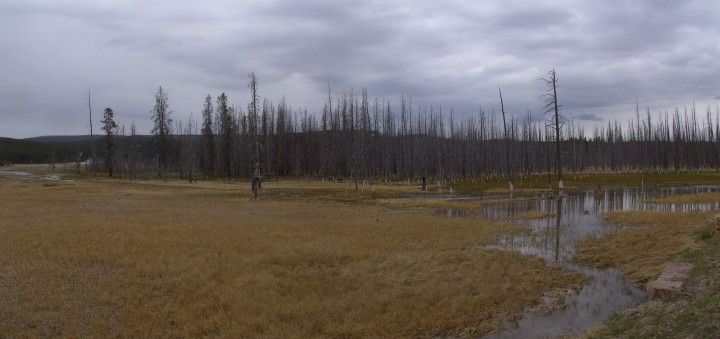

Here are some more pictures to keep record of some wood fires:



(Please note the height of the snow in May compared to the height of the trees on the next picture!)
Books — I read plenty of them in Yellowstone National Park
Or actually, I read them during the bus rides which took me more than 8,000 km through the continent.
 The first one was “Chaos — Making a new science” by James Gleick. My room mate Inaki gave it to me a few weeks ago. When first published in the 1980s the scientific field of “Chaos” (or studying the complex dynamic behavior of nonlinear systems) was still pretty young. The book tells the stories of Lorenz, Mandelbrot, Feigenbaum and a bunch of other non-standard researchers. It’s really well-written, just one or two chapters got a bit too philosophical for my taste. As a control engineer I could see where many of the basic things that we learned in our undergrad programs came from. If you’re interested in the origins of fractals, strange attractors or period-doubling bifurcations, read this book (but don’t expect to learn too much that you can immediately apply — it’s more like a history book).
The first one was “Chaos — Making a new science” by James Gleick. My room mate Inaki gave it to me a few weeks ago. When first published in the 1980s the scientific field of “Chaos” (or studying the complex dynamic behavior of nonlinear systems) was still pretty young. The book tells the stories of Lorenz, Mandelbrot, Feigenbaum and a bunch of other non-standard researchers. It’s really well-written, just one or two chapters got a bit too philosophical for my taste. As a control engineer I could see where many of the basic things that we learned in our undergrad programs came from. If you’re interested in the origins of fractals, strange attractors or period-doubling bifurcations, read this book (but don’t expect to learn too much that you can immediately apply — it’s more like a history book).
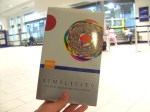 Afterwards I read “Simplicity” by John Maeda (you can check out this website). It was a present from Prof. Allgöwer. The author (a design professor) gives a set of ten laws of simplicity, and he explains them very lively with modern examples. The author’s Ipod (which he rarely uses) is introduced as a device which achieves simplicity by reduction, and by being something small and fragile. It’s nice to see that the authors really obeys his own theories, that is repeating himself as a method of teaching, and always giving a lot of context. In his case the contexts are often stories from Japan. I especially remember two of them. One is about “omakase“, something you can order in a sushi restaurant. It basically means that you leave what to cook up to the cook. (I wish fast food restaurants would offer this: I just give them money and they give me something to eat!) And there was a story about a fenced-off area next to a sacred place. Maeda had no idea what it was used for, until it turned out that people put their cars into it to receive an annual prayer against traffic accidents and breakdowns. :-)
Afterwards I read “Simplicity” by John Maeda (you can check out this website). It was a present from Prof. Allgöwer. The author (a design professor) gives a set of ten laws of simplicity, and he explains them very lively with modern examples. The author’s Ipod (which he rarely uses) is introduced as a device which achieves simplicity by reduction, and by being something small and fragile. It’s nice to see that the authors really obeys his own theories, that is repeating himself as a method of teaching, and always giving a lot of context. In his case the contexts are often stories from Japan. I especially remember two of them. One is about “omakase“, something you can order in a sushi restaurant. It basically means that you leave what to cook up to the cook. (I wish fast food restaurants would offer this: I just give them money and they give me something to eat!) And there was a story about a fenced-off area next to a sacred place. Maeda had no idea what it was used for, until it turned out that people put their cars into it to receive an annual prayer against traffic accidents and breakdowns. :-)
 The third book is “Das ist o.B.d.A. trivial” by Albrecht Beutelspacher. It was also a present from Prof. Allgöwer. Here the author (a math professor) gives an introduction to mathematical writing. Why should a ∀ always go before a formula and not behind it. And why should we really pay attention when we put a ∀ and an ∃ into the same formula: “∀m ∃f: h(m,f)” means something else than “∃f ∀m: h(m,f)”. Consider m=male, f=female and h=have a relationship. And when to say “eine Abbildung auf eine Menge” and when to use “eine Abbildung in eine Menge”. When to use “one”, “I” or “we” in written texts, and what a mathematician things about the ≡ sign (the answer is disappointing).
The third book is “Das ist o.B.d.A. trivial” by Albrecht Beutelspacher. It was also a present from Prof. Allgöwer. Here the author (a math professor) gives an introduction to mathematical writing. Why should a ∀ always go before a formula and not behind it. And why should we really pay attention when we put a ∀ and an ∃ into the same formula: “∀m ∃f: h(m,f)” means something else than “∃f ∀m: h(m,f)”. Consider m=male, f=female and h=have a relationship. And when to say “eine Abbildung auf eine Menge” and when to use “eine Abbildung in eine Menge”. When to use “one”, “I” or “we” in written texts, and what a mathematician things about the ≡ sign (the answer is disappointing).
If one of you wants to read the first book, ask Inaki or check out bookcrossing.com or ebay.de or amazon.de. Amazon seems to be the best choice. If one of you wants to read the second or third book, I can give it to you. Just let me know, or steal-n-eventually-return it.
Is ecofriendly traveling possible in the US? — Revisited!
A few weeks ago I told you about my my attempt to verify if eco-friendly traveling is possible in the United States. I’ve just returned from this trip, and I can give good news: Everything worked just fine!
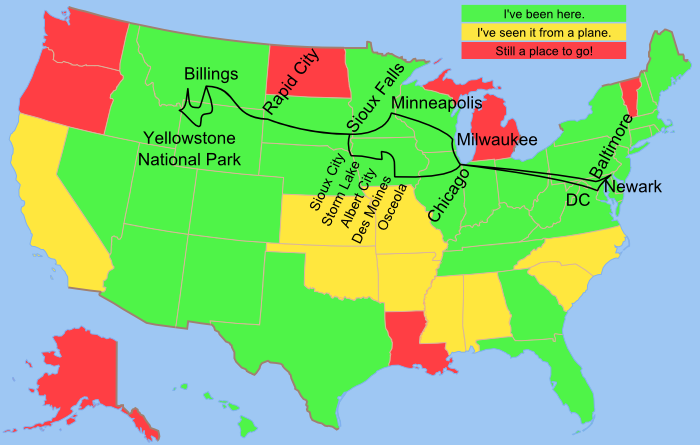
Since I didn’t use a plane I also got many new “green” states. I took a train from Delaware through Maryland to DC, then another one from DC through Pennsylvania, Ohio and Indiana to Chicago, Illinois, and a third train from Chicago to Osceola, Iowa. From then on I switched to buses. I visited relatives in Des Moines, Albert City and Storm Lake (all Iowa), spent a night in South Sioux City (say: “Soo City”), Nebraska and went through Sioux Falls (say: “Soo Falls”) to Rapid City, South Dakota. I went further west to Billings, Montana, where I started a discovery tour through America’s first National Park, the Yellowstone. I’ve seen both Wyoming and Idaho in that area.
On my way back from Billings, MT to Wilmington, DE I chose the cheapest bus ticket I could get, and that was about 2200 miles for $83. Awesome! And best of all: The bus went through Minneapolis, Minnesota and Milwaukee, Wisconsin. Two new states! :-)
As you can see in my state overview, I’ve now seen more than 52 states in 8 months. Actually I’m counting 54 states in 7 months now! :-) :-) :-)
3x News
1. Wolfsburg won the German Soccer Championship! (Okay, that wasn’t too difficult since the last two matches were against Hanover and Bremen…)
2. Horst Köhler won the presidential election! (That wasn’t too difficult either since his opponents were a swan and an actor)
3. The Yellowstone National Park is awesome! But they don’t have Wifi inside the park, so I had to drive to the West Entrance to check the soccer and the election results. And guess what? About 10 miles west of the the Yellowstone National Park begins Idaho. I’ve visited that state according to the FIFO method (foot in, foot out):

Is eco-friendly traveling possible in the United States?
 Last week I received a postcard from Spain (Thank you, René!). This is René’s comment on photo on the postcard:
Last week I received a postcard from Spain (Thank you, René!). This is René’s comment on photo on the postcard:
Eine Ansicht von Mitteldeutschland in 50 Jahren, wenn du mit deinem Audi/Airbus/Boeing weiter so viel CO2 ausstößt wie bisher *g*.
Alright, reasons enough for me to start a new journey! I’ll go to Iowa to visit some relatives; afterwards I’ll go to Rapid City to see the Mount Rushmore, and last on my list is the Yellowstone National Park. To make sure I don’t use any Audi, Airbus or Boeing I’ll only use trains and buses to get from one place to the other, so that’s Amtrak, Greyhound and Jefferson Lines. I have to go about 8000km, which is about one week of continuous traveling. I’ll be back around March 28.

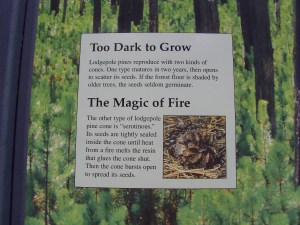


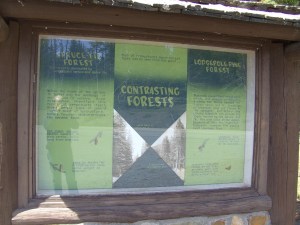
6 comments